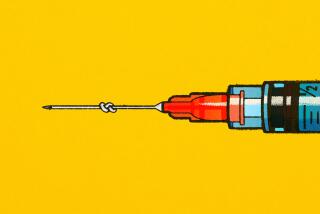Breasts, redefined
- Share via
If all goes well, Akinyi Okoth, a single, 32-year-old Manhattan woman, will come home from a lengthy vacation later this summer with the breasts she has long wanted.
Like a quarter of a million U.S. women each year, Okoth plans to have her breasts enlarged with implants. She’s always felt unfairly shortchanged when it comes to her breast size, she says, pointing out that her sisters are well-endowed. Besides, she thinks clothes look better on bustier women.
“I feel good about myself, but I think breast implants will make me look better and change the way I think and act,” says the information technology professional.
The Food and Drug Administration may still be considering whether silicone gel implants -- like saline implants -- are safe for general use in augmentation, but for Okoth, it’s a moot point. She’s made up her mind to obtain what nature itself didn’t create.
Her determination underscores a point that has often been overlooked in the debate over the safety of silicone implants, pulled from the market 13 years ago: U.S. women want augmentation, silicone or no silicone.
Even as public health officials, breast manufacturers and anti-implant activists have been warring over the risks of silicone implants, more women than ever are paying the price -- and taking the risk -- to have perkier or bigger breasts.
Sometimes the changes are subtle, noticed primarily by the woman herself. Often they’re obvious, meant to be noticed by almost everyone. In any case, augmentation no longer carries the stigma it once had.
In 1992, the year silicone implants were banned for general use, an estimated 32,607 women underwent augmentation -- elective surgery to enhance breast size. Since then, augmentations have soared to an estimated 252,915 a year, according to the American Society of Plastic Surgeons.
“Breasts sell,” said Ann Kearney-Cooke, a Cincinnati psychologist who has studied body image. “Whenever you have a body part that there is such a high charge around in the culture, I think that is when you see people getting obsessed and dissatisfied.”
In part, the popularity of augmentation surgery can be traced to the growing overall acceptance of plastic surgery. Cosmetic procedures have increased 26% since 2000, the plastic surgeons group says.
“The whole idea of remodeling your body has become a fashion statement, almost like changing your wardrobe,” says Rita Freedman, a clinical psychologist in Harrison, N.Y., who has studied body image and breast implants.
Even taking that trend into account, breasts have become bigger than ever.
Aggressive marketing and advertising, fashion trends and cosmetic surgery television shows such as “Extreme Makeover,” have all contributed to a culture in which full, bouncy, youthful breasts are part of the ideal female body image, says Freedman.
Large breasts “are advertised indirectly every time a Victoria’s Secret ad comes into your house,” she says.
A woman fresh from a plastic surgery center may still elicit the occasional snicker, but many more women undergo augmentation with no embarrassment. A brassiere manufacturer, Bra straps.com, recently introduced a new bra intended to create the appearance of breast implants by lifting and separating each breast to achieve that can’t-be-natural look.
The rounded, high profile of implants may not be normal, but they can seem to be the norm. In some social circles, there may even be pressure to conform.
“It’s the fashion to have done it rather than not to have done it,” says Freedman. “People used to go to South America and have it done in secret. Now people come back after surgery almost bragging about what they’ve done.”
Once a procedure -- whether Botox or face-lifts or implants -- achieves critical mass, women can find themselves questioning why they aren’t undergoing a makeover of some sort. Shunning cosmetic surgery, in some social circles, can be a new version of “letting yourself go.”
“Cosmetic surgery has a way of creeping down the block,” Freedman says. “You catch the need for it. Something that seemed OK to you before, when you see someone else has corrected it, it’s not OK any more. [The need] travels among the family. It travels among the social circle.”
*
Different motivations
Augmentation patients typically fall into three groups, says Dr. Steven Teitelbaum, a Santa Monica plastic surgeon. These include women who want the “Baywatch” look; what Teitelbaum calls “the smallest group but, unfortunately, the poster child for augmentation.” These mostly younger women were children when implant safety questions first emerged, he notes, and may be especially disinterested in the safety controversy.
The more typical augmentation patients, he says, are women who never developed breasts during puberty and the “postpartum” group, women whose breasts were once satisfactory but have changed due to aging, pregnancy and breast-feeding.
He says the surge in women seeking augmentation is due largely to the postpartum group and attitudes among these women about maintaining the figures of their youth.
According to a 2003 survey of 5,000 women funded by the Aesthetic Surgery Education and Research Foundation, the median age of augmentation patients is 34, and 75% are married.
“Women want their bodies back after finishing with their babies,” Teitelbaum says. “Women have more of a sense that they deserve it. They are working so hard on their bodies at the gym, and [breasts] are one thing they can’t fix themselves.”
David Sarwer, a University of Pennsylvania psychologist who has studied augmentation, also disputes the notion that most women who want implants are very young and are simply trying to attract new romantic partners.
“Women consistently tell us they are doing this for their own sense of self-esteem and quality of life,” he says. “Today many more of us see [body image] as an important part of personal happiness.”
In a 2003 study published in the Journal of Women’s Health, Sarwer queried 25 breast augmentation patients and 30 physically similar women who were not interested in augmentation of their body. He found that augmentation patients were motivated to have surgery primarily because of their dissatisfaction with their breasts rather than pressure from romantic partners or because of cultural influences regarding beauty.
At Rodeo Drive Plastic Surgery in Beverly Hills, Dr. Lloyd Krieger says 70% of his augmentation patients are women who want to restore their breasts to a more youthful-looking shape or create what they perceive are normal-sized breasts.
“You’d be surprised about who is getting implants. It’s not the girls in college who want to wear bikinis on the beach. They are only a small part of it,” says Krieger. “Many people just want their shape back because they feel they’ve lost something. Or they don’t want to be big; they just want to be normal.”
Studies show, however, that women who desire implants are more concerned with their appearance than the average woman, says Kearney-Cooke. The 2003 survey found that the most popular reason for seeking augmentation -- stated by 91% of women -- was to look better without clothes.
But, she adds, augmentation patients often experience a more positive outlook on life after the surgery. “Feeling attractive and feminine and sexy is healthy for people. When you feel that way, that’s a great energy.”
Freedman doesn’t buy the argument that women seeking augmentation are doing it solely for themselves and their self-esteem.
“Nobody does this just for themselves,” she says. “The decision that seems to be your own is a product of what you’ve learned from the culture. The youthful, high, pointed breasts that have been revered as the perfect breasts have been learned from the culture.”
She suggests that societal pressure to look good has overtaken concerns about safety. Both silicone and saline implants can harden and rupture, requiring surgical removal. Infections can occur after surgery. Implants can cause a lack of sensation in the nipple, impair lactation and complicate mammography.
Evidence that the silicone devices in particular could rupture and cause health problems prompted restrictions on their use. Although studies now have largely ruled out a link between silicone and serious illness such as autoimmune disease, questions remain about the long-term safety of silicone implants and how often the implants break.
*
Weighing pluses, minuses
In the years since the moratorium, most of the implants used in this country have been filled with saline, although silicone implants are still available to women who’ve had a mastectomy, who are part of a clinical study or who are replacing implants.
Teitelbaum says most women have concluded that the benefits outweigh the risks. Women will have no qualms about choosing the cosmetically superior silicone implants for augmentation should the FDA lift the moratorium, he and other plastic surgeons say. More than 90% of women in Europe, where both silicone and saline are available, choose silicone.
Many women seeking augmentation are annoyed that the matter is still being debated. Silicone implants simply look more natural and feel better than the saline versions, they say.
Even if the FDA maintains the moratorium, it probably won’t slow the pace of augmentations. The 2003 survey found that 94% of augmentation recipients would recommend the procedure to friends or family.
As for Okoth, she’s prepared. If the moratorium is continued, she’ll probably fly to Brazil to undergo augmentation surgery there. Silicone implants are legal in that country.
“But I should be able to make the choice,” Okoth says. “And everything I’ve read says silicone is better.”






